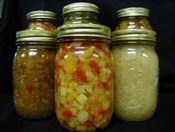Safe, high quality home canned foods begin with the right equipment used properly. Why risk losing your time and food dollar through spoilage? Check and assemble good equipment before the season begins, then maintain it well.
- Check jars and bands. Discard chipped jars and rusted or distorted bands.
- Have dial pressure gauges checked.
- Check seals on last summer’s produce.
- Make plans to use up last summer’s produce (both frozen and canned) to make room for new products and to prevent food waste.
- Check files to make sure your food preservation information is complete and up-to-date.
HOME CANNER’S QUESTIONS
Q. I have several peanut butter, pickle and quart-sized mayonnaise jars which I would like to be able to use for canning. Is it safe to use these jars in a boiling water bath canner or a pressure canner?
A. NO! These jars are manufactured for single use. They make good refrigerator storage jars, are a perfect solution for your picnic packaging needs, or can be recycled at your local recycling center. Standard Mason type canning jars are made to be used many times and to withstand the heat necessary in the home canning process.
Q. How long is it safe to store canned food?
A. For optimum quality of food, plan to use home-canned food within one year. As the canned food ages, the quality of the food goes down, but it is still safe to consume as long as the seal is intact and there is no sign of spoilage. Whatever the age, ALWAYS boil low-acid, home pressure canned vegetables a full 10 minutes or simmer for 15 minutes to destroy any possible botulism toxins. Cream style corn, meat and poultry should be simmered 20 minutes, and fish for 15 minutes, after bringing to a boil. DO NOT taste prior to boiling.
Q. Which pressure canner is more accurate-- the kind with a dial gauge or the one with a weighted gauge control?
A. Both are accurate if used and cared for according to the manufacturer’s instructions. Some people like numbers on a dial; others prefer the sound (“jiggling” or “rocking” noise) of the weight control. Dial gauges need to be checked for accuracy; weighted gauges do not need checking.
Resource: Cindy Shuster, Associate Professor, Extension Educator, Family & Consumer Sciences, Perry County, Ohio State University; revised by Judy Price and Katherine Humphrey, NYS Food Preservation Experts, Cornell Cooperative Extension, 5/2009.







